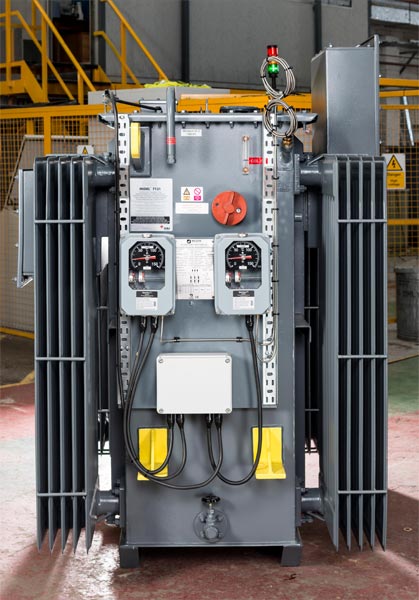A Basic Guide to Transformers

It’s fair to say that, until you need to know about them, transformers don’t exactly entice the public imagination. These essential but ultimately functional devices are among some of the most important parts our infrastructure, but apart from sharing their name with a toy & movie brand if you asked a member of the general public what a transformer is, how it works or why we need them you’re more likely to get a blank stare than an enthusiastic explanation.
This of course is unsurprising, why should the general public know what a transformer is if they never have to work with one? What this creates, however, is a collection of misconceptions and misunderstandings. This blog seeks to make clear what a transformer is, why we need them and to start to explain how by altering the designs and materials of transformers we can create better, more efficient energy infrastructure.
The first thing you need to know to understand transformers is how electricity works. Electricity’s power is defined by two factors – voltage and current. A really great way to visualize these two factors is to compare electricity to water, with voltage being the pressure by which water comes out of the tap and current being defined as the size of the pipes and tap determining how much water can get through. This demonstrates even with the same amount of water flowing through a system, you can see how a higher pressure (voltage) blasting through the system, or incredibly wide pipes could completely change how that system works and affects things.
Now, while this metaphor helps visualise electricity, when it comes to transferring energy we encounter a problem that is unique to power. When we transmit energy there is a natural resistance in the line we send it down that contributes to energy loss. Imagine if a pipe was made of sponge an absorbed water along the route, you’d want to reduce the amount of water lost to the absorbent pipe. The only way we can reduce the impact of the resistance is to reduce the current and increase the voltage (use narrower piping and blast the water down the pipes quickly). This lessens the impact of the resistance and means that less energy is lost during transmission. As a result, we opt for a high voltage, low current solution.
It’s a good way to keep losses low, but when the electricity gets to the other end new problems arise. Imagine if, when you turned on the tap, the water shot out at such a powerful rate it smashed all the plates in your sink and then decided to also blast the sink out of the wall and cause chaos in your kitchen. This would be what happened if you simply took the high voltage power supplied by the National Grid directly and plugged it into your apparatus, except instead of water you’d have thousands of volts causing your equipment to explode. In order to actually make use of the energy we have to drop the voltage and bring back up the current, and its here that transformers come into the picture.
Ultimately, a transformer is a box with coils and coils of wiring, a big metal core and cooling system usually made up of Oil, Midel or Cast Resin. The idea is that you take your high voltage electricity and use it to magnetise the core. This produces an electrical field that energises the coils on the other side that has fewer turns (or more if you want to increase the voltage). If you want to use the water metaphor again, think of a transformer as pool in the middle of a fast flowing stream, it slows down the flow. This makes the electricity usable, rather than power hosing your sink your tap happily lets the water flow out at a usable rate.
Of course this process is a tricky one, and while every effort is made to reduce a loss of energy the process produces a lot of heat. This is why the cooling system is in place, the coils are usually submerged in oil or Midel (a specially created synthetic oil with a much higher ignition point) as they don’t conduct electricity very well and is thus a safer substance to use than water (plus water boils at 100 degrees Celsius, whereas the mineral oil found in transformers has an ignition point of 140 degrees Celsius. Midel can get even hotter, and is our substance of choice). Other losses can occur in the transformer’s core, but this can be mitigated by using amorphous metals (another fascinating topic you can learn more about in our white paper). The ideal transformer would simply change the voltage and current without any of these heat losses, acting as the safety buffer between the power supply and your equipment.
So there you have a basic explanation of what a transformer is, does and how it works. This basic understanding is a vital part of helping you make decisions when it comes to your energy infrastructure, and gives you a good springboard on which to learn more about how different transformers can help you save money and energy. So the next time someone asks what a transformer is you’ll know exactly what to tell them, and it isn’t a robot that is also a car.
If you enjoyed this blog and want to stay up to date on Wilson Power Solutions News, sign up to our newsletter:
Sign Up Now 4 Apr 2017
4 Apr 2017IETF: Industrial Energy Transformation Fund – Phase 3
Industrial emissions account for around 18% of UK emissions. To reach the Net Zero target in 2050, industrial emissions need to fall by around 90% from today’s levels. Industrial Energy Transformation Fund (IETF) launched Phase 3 of industrial grants on Monday 29 January 2024, with the closing date on Friday 19 April 2024, and aims […]
 23 Feb 2024
23 Feb 2024Guide to Replacing Transformers
The third part of the Intergovernmental Panel on Climate Change (IPCC) Sixth Assessment Report (AR6) was published earlier this month. Scientists warn that limiting global warming to 1.5°C is beyond reach but restricting temperature rise to no more than 1.5C to 2C could be the range that will minimize the likelihood of reaching critical environmental […]
 22 Apr 2022
22 Apr 2022IETF: Industrial Energy Transformation Fund FAQ
The Industrial Energy Transformation Fund (IETF) was designed by the UK government to encourage energy-intensive businesses to cut their carbon emissions and reduce their energy waste by switching to energy-efficient low-carbon technologies. A budget of £315 million was allocated by the government to be spent through the IETF. BEIS manages England, Wales and North Ireland’s […]
 4 Apr 2022
4 Apr 2022










